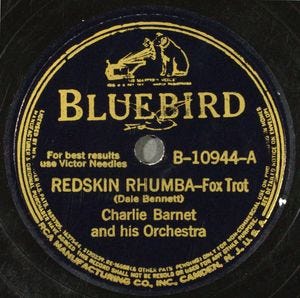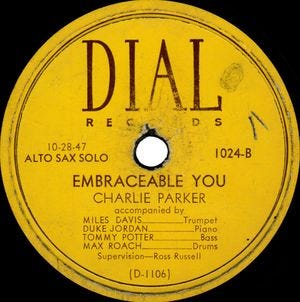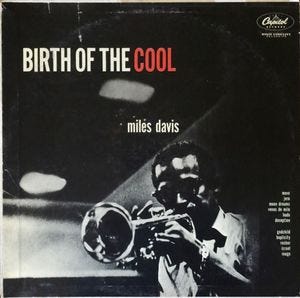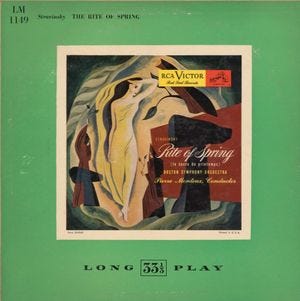Some Jazz Records: Cecil Taylor Clippings (Part 2)
Comments on recordings from musicians and other actors of the jazz scene. Random and not-so-random listening cues from the archives.
Charlie Barnet and His Orchestra, Redskin Rhumba/Southern Fried, Bluebird B-10944, 1940, 10" 78 rpm.
During a 1978 interview with Cadence magazine, Cecil Taylor mentioned that he didn’t arrive at Duke Ellington’s music right away during his childhood discovery of jazz. An Ellington-influenced bandleader served as an intermediary. "It wasn’t until I got involved with Charlie Barnet that the next step was Ellington. 'Redskin Rhumba' was my favorite. Also the sound of that band was different from even the Woody Herman band. […] I would say it had a different kind of intonation." The Barnet 78, recorded and released in 1940, can be heard at the University of California, Santa Barbara’s Discography of American Historical Recordings.
Charlie Parker, Bongo Bop/Embraceable You, Dial 1024, 1948, 10" 78 rpm; and Miles Davis, Birth of the Cool, Capitol T-762, 1957, LP.
"That remarkable record that the master Bird [Charlie Parker] made, it was merely the ground theme of 'Embraceable You,' and Bird took this extraordinary solo, and then you heard Miles [Davis] come and pause and make sound then, we knew that was the beginning of another voice," Cecil Taylor told Perfect Sound Forever. The pianist was referencing an October 1947 New York session first made available on Dial 78s. "And soon after that, Birth of the Cool with the great master Gil Evans," Taylor continued. "We heard the fluidity and love of Mr. Davis… Davis was one of the greatest organizers of musical sound this country has ever known." The Davis recordings eventually issued by Capitol under the Birth of the Cool title were made in 1949-50.
Igor Stravinsky, The Rite of Spring, the Boston Symphony Orchestra conducted by Pierre Monteux, RCA Red Seal LM 1149, 1951, LP.
During an extensive conversation with Cecil Taylor published in Coda in 1975, Bill Smith brought up the pianist’s frequent characterization as mainly European-influenced. "I don’t have anything to deny," Taylor said. "I was only a product of the European nation, I went to the conservatory, and I must admit that when I first… And I’m not ashamed of this… When I heard Stravinsky’s Rite of Spring at Symphony Hall in Boston it was a devastating experience to me. And you know it’s very cool, see? I admit I’m rather hard on European musicians, I wouldn’t walk across the street to hear most of them, right? But that’s because I’m a musician." Allan Chase’s research has dated Taylor’s enrollment at Boston’s New England Conservatory to 1947-51. During this period, The Rite Spring was only staged once at Symphony Hall, over three days. Pierre Monteux, who had conducted the original 1913 Paris premiere of Stravinsky’s work, directed the Boston Symphony Orchestra. A recording of the closing performance was issued later that year. It can be heard at the Internet Archive. (Shortly thereafter, Taylor referred in a letter to another version of The Rite of Spring as "terrible," he was probably thinking of a recent London Records release.)








Enjoying these pages. Posts may be relatively short - in terms of text - but following the links and references adds much richness and interest.